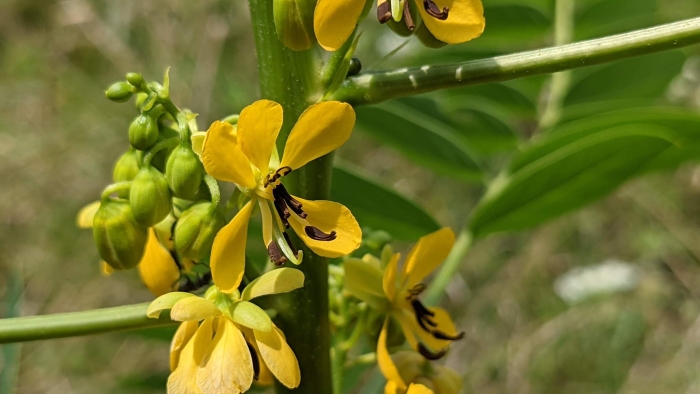Maryland Senna
(Senna marilandica)
Maryland Senna (Senna marilandica)
/
/

john_hall
CC BY 4.0
Image By:
john_hall
Recorded By:
Copyright:
CC BY 4.0
Copyright Notice:
Photo by: john_hall | License Type: CC BY 4.0 | License URL: http://creativecommons.org/licenses/by/4.0/ | Rights Holder: john_hall | Publisher: iNaturalist | Date Created: 2021-07-25T13:25:10-07:00 |


















































Estimated Native Range
Summary
Senna marilandica, commonly known as Maryland Senna, is a deciduous perennial herb native to open woodlands, fields, and along streams throughout the Central and Eastern United States. It typically grows to a height of 3 to 6 feet (0.9 to 1.8 meters) and a width of 2 to 3 feet (0.6 to 0.9 meters). Maryland Senna features pinnately compound leaves and showy, bright yellow flowers that bloom in the summer, followed by distinctive seed pods. The plant is particularly noted for its ability to attract butterflies and other pollinators.
Maryland Senna is valued for its ornamental qualities, including its bright flowers and its use as a naturalizing plant in wildflower gardens, meadows, and restoration projects. It is drought-tolerant once established, making it suitable for xeriscaping. This plant prefers full sun but can tolerate partial shade and is adaptable to a range of soil types, provided they are well-drained. While generally low-maintenance, it can be susceptible to leaf spot diseases in humid climates. Maryland Senna is also recognized for its historical use in herbal medicine, although it should be used with caution due to its strong laxative properties.CC BY-SA 4.0
Maryland Senna is valued for its ornamental qualities, including its bright flowers and its use as a naturalizing plant in wildflower gardens, meadows, and restoration projects. It is drought-tolerant once established, making it suitable for xeriscaping. This plant prefers full sun but can tolerate partial shade and is adaptable to a range of soil types, provided they are well-drained. While generally low-maintenance, it can be susceptible to leaf spot diseases in humid climates. Maryland Senna is also recognized for its historical use in herbal medicine, although it should be used with caution due to its strong laxative properties.CC BY-SA 4.0
Plant Description
- Plant Type: Herb
- Height: 4-6 feet
- Width: 2-3 feet
- Growth Rate: Rapid
- Flower Color: Yellow
- Flowering Season: Summer
- Leaf Retention: Deciduous
Growth Requirements
- Sun: Full Sun
- Water: Medium, High
- Drainage: Fast, Medium
Common Uses
Bee Garden, Bird Garden, Butterfly Garden, Drought Tolerant, Low Maintenance, Showy Flowers, Street Planting
Natural Habitat
Open woodlands, fields, and along streams throughout the Central and Eastern United States
Other Names
Common Names: American Senna , Maryland Wild Senna , Wild Senna , Amerikansk Senna
Scientific Names: Senna marilandica , Cassia marilandica , Cassia medsgeri , Ditremexa medsgeri , Ditremexa nashii , Ditremexa marilandica , Cassia acuminata , Cassia reflexa , Cassia marilandica var. floridana , Cassia succedana , Senna riparia
GBIF Accepted Name: Senna marilandica (L.) Link